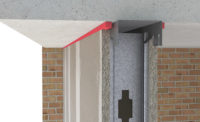Recently, the green building sector has outpaced overall construction growth in the U.S., generating $167.4 billion in GDP—and it doesn’t seem to be slowing down anytime soon. In fact, green construction is expected to generate $190.3 billion in labor earnings by 2018, according to a 2015 Green Building Economic Impact Study by the U.S. Green Building Council and Booz Allen.
Given the demands of the market, contractors should be aware of the opportunity at hand and factor sustainability into all aspects of construction, including wall and ceiling materials like drywall and insulation. Those that evaluate the long-term financial and safety benefits of sustainable practices will contribute to the growing chunk of commercial office space that’s been certified as “green” or “efficient,” which now stands at 38 percent across 30 office markets in the U.S. In October 2017, more than 19.3 billion square feet of building space was LEED-certified worldwide and an additional 2.2 million square feet achieves LEED certification each day.
Recycle Construction and Demolition Materials
There are a number of ways contractors can develop a green construction site, starting with Sustainable Materials Management, an EPA process that identifies construction and demolition material for recycling. Most gypsum drywall and ceiling tiles are disposed of in landfills but contractors can significantly reduce their carbon footprint by recycling these items through construction and demolition recyclers.
About 13 million tons of gypsum wallboard debris are generated in the U.S. every year, with 75 percent of this debris making its way to landfills.
Recognizing the need for more closed-loop processes—which aims to remove disposal and extraction of new resources altogether—and contributing less to landfills, construction and demolition recyclers have created new products from materials collected or sold recycled material to manufacturers to extend their lifecycle. For example, once recycled gypsum is processed, it can be made into various agricultural products, such as soil amendment or as animal bedding.
Consider Sustainable Building Materials
According to the EPA, 534 million tons of construction and demolition materials were generated in the U.S. in 2014, a large percentage of which could have been diverted through innovative product development and material recycling. Most industries in the U.S. still operate within the linear economy, which relies on a “take, make and dispose” mentality. However, innovative manufacturers are integrating recycling materials into new products, and finding alternative uses for post-consumer materials in either the same or adjacent industries by applying the circular economy framework. Several wall and ceiling building products follow this framework, helping contractors meet LEED or WELL Building Standards.
Sustainable materials such as cork, recycled carpet, recycled clothing and PET fibers are not only environmentally beneficial, but tend to be safer for construction workers and end-users. Most manufacturers seek post-consumer materials free of VOCs and added-formaldehyde: when a sustainable product is used in wall construction, it reduces health risks for construction workers or building occupants if they’re exposed.
Evaluate the Long-Term Impact of Sustainability
While the initial cost may inhibit contractors from choosing more sustainable, innovative options in the short-term, these products are actually more valuable for your construction site due to their long-term safety, financial and environmental impact.
It’s Healthier: The majority of construction debris is disposed of in roughly 2,000 active landfills in the U.S., causing growing amounts of methane and hydrogen sulfide gas to expel into the atmosphere. Research has shown these types of gases and chemicals can increase the risk of adverse health effects of individuals living near landfill sites, including headaches, sleepiness, respiratory symptoms, psychological conditions and gastrointestinal problems. You can avoid contributing to these side effects of standard waste collection by recycling post-consumer building materials and installing sustainable products in your building.
It’s a Better ROI: When it comes to construction projects, fees quickly add up, but what may be an expensive undertaking in the short-term could save you thousands down the line. For example, hiring construction waste collectors to recycle your debris may be the more expensive option, but when the alternative is paying to truck your debris to out-of-state landfills, not to mention a landfill fee, it’s better in the long run—financially and environmentally. Responsible construction and demolition waste management as well as using sustainable building material can earn you points toward a LEED certification. (By the way, LEED buildings report almost 20 percent lower maintenance costs than typical commercial buildings.)
It’s Better for the Economy: Although environmental groups have made great strides in proving the value of the circular economy, most industries in the U.S. still operate within the linear economy. By incorporating the framework of the circular economy—a focus on resilience and decoupling economic activity from the consumption of finite resources, while keeping products and materials inside the system—into your construction project, you’ll join trailblazing industries attempting to make business more sustainable. Local economies see a benefit from sustainable business practices too: when local manufacturers invest in the creation of recycled products, it generates additional labor income.
Construction waste, like municipal and household waste, is very much an “out of sight, out of mind” concept: once you no longer see it, you forget about it. This is easily accomplished on a job site, where waste is trucked away at the end of a project, but it’s up to the person in charge—that’s you—to implement responsible business practices. That means recycling and using sustainable products wherever possible in your wall construction. Keeping our environment a safe place to live and build is a community effort: every little bit helps.













Report Abusive Comment